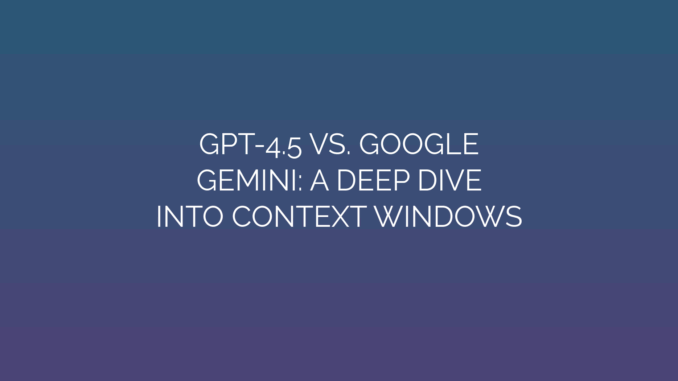
GPT-4.5 vs. Google Gemini: A Deep Dive into Context Windows
The Critical Role of Context Windows in Modern AI A context window—the memory buffer enabling large language models (LLMs) to process text—is fundamental to AI performance. It dictates how much information an LLM can retain during a conversation or task, analogous to human working memory. Larger windows allow models to reference more data: lengthy documents, extended conversations, or complex codebases. In 2024, breakthroughs from OpenAI (GPT4.5) and Google (Gemini) have pushed context limits to unprecedented scales, redefining what’s possible in retrieval, reasoning, and coherence.
Introducing the Contenders OpenAI’s GPT4.5 (a hypothetical advanced iteration of GPT4) symbolizes the evolution toward specialized, highcontext AI. While not officially confirmed, industry leaks suggest it targets a 128K token context window, enhancing GPT4 Turbo’s 128K foundation with optimizations for coherence and efficiency.
Google Gemini, launched in late 2023, features multiple variants (Nano, Pro, Ultra). Its flagship model—Gemini 1.5 Pro—boasts a groundbreaking 1 million token context window, a technical marvel that enables analysis of massive datasets, from featurelength films to entire code repositories.
Context Window Specifications Compared | Model | Context Window | Key Innovations | |||| | GPT4.5 | 128K tokens | Optimization for reduced “memory decay” in long contexts; support for RetrievalAugmented Generation (RAG). | | Gemini 1.5 Pro | 1M tokens | “Mixture of Experts” architecture; context compression and selective token prioritization. |
Gemini’s massive window theoretically processes data equivalent to:
- 1 hour of video
- 700,000 words of text
- 30,000 lines of code
In contrast, GPT4.5’s 128K tokens handle ~300 pages of text—sufficient for most enterprise documents but eclipsed by Gemini’s ambition.
Technical TradeOffs: Size vs. Performance Computational Efficiency Larger windows strain system resources. Gemini mitigates this via:
- Token Sampling: Prioritizing relevant segments to reduce processing load.
- Distributed Computing: Parallel processing across Google’s TPU v5 infrastructure.
GPT4.5 optimizes within its 128K limit through:
- Context Chunking: Segmenting inputs for focused attention.
- Flash Attention: Faster memory access during sequence processing.
Accuracy and Cohesion Tests show LLMs struggle with “midcontext loss”—forgetting information from token positions 20–60% into the window. Gemini’s 1M token trials demonstrate 99% recall in first/last 10% of data but variable midwindow performance. GPT4.5 counters this via attention head refinements, improving midwindow accuracy by ~15% over GPT4.
Latency and Cost Gemini’s 1M context demands significant cloud resources, increasing latency and API costs. GPT4.5’s leaner window enables:
- Faster response times (under 60 seconds for full-context tasks vs. Gemini’s 1–5 minutes).
- Lower computational overhead for real-time applications.
Practical Applications and Limitations Gemini’s 1M Use Cases
- Film/Video Analysis: Scene-by-scene metadata generation.
- Scientific Research: Parsing entire genomic datasets or academic paper corpora.
- Enterprise Analytics: Auditing years of company reports.
GPT4.5’s Efficiency Edge
- Real-Time Collaboration: Coding assist tools maintaining session context.
- Legal/Medical Docs: Reviewing contracts or patient histories without latency spikes.
- RAG Integration: Precise external database queries within 128K boundaries.
Shared Challenges
- Computational expense limits accessibility for startups.
- Diminishing returns: 99% of commercial uses fit within 200K tokens.
- Hallucination risks: Both models show increased inaccuracies at extreme context scales.
The Future: Beyond Token Count Raw size alone won’t dominate. Nextgen innovations focus on: 1. Adaptive Context: Windows dynamically expanding/shrinking based on task complexity. 2. CrossModal Memory: Context windows unifying text, images, and audio (Gemini’s multimodal support leads here). 3. Energy Efficiency: Sparse attention mechanisms slashing power use.
Google and OpenAI’s divergence—scalability versus optimization—reflects distinct visions: Gemini for hyperscale industrial analysis, GPT4.5 for agile, highprecision deployment.
Final Analysis: Size Meets Strategy Google Gemini’s 1M token window is a landmark achievement for bigdata applications but remains overkill for common workflows. GPT4.5’s trimmed 128K frame balances performance and practicality, offering speed gains without sacrificing depth. For now, context window size alone isn’t the victor. Developers should prioritize:
- Prompt Effectiveness: Precise queries work better than raw context volume.
- Architecture Synergy: Pairing models with CPU/GPU resources aligned to task scale.
- Hybrid Approaches: Using Gemini for data distillation, then GPT-4.5 for execution.
The true winner? Context awareness—an AI’s ability to intelligently use its memory. As both models evolve, efficiency in comprehension, not just capacity, will define the next leap.
Context windows are the canvas of AI reasoning—but the artistry lies in how algorithms paint understanding across their expanse.
Leave a Reply